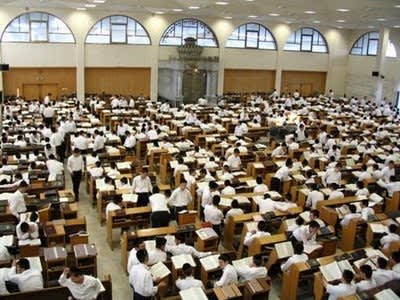One of the expressions of mourning on Tisha beAv is that we refrain from studying Torah, just as a mourner does (SA OC 554). The gemara bases this rule on the verse from Tehillim (19:9) “The commands of HaShem are straight, rejoicing the heart” (Taanit 30a).
However, this prohibition is not absolute. The same passage in Taanit states, “One may read the lamentations in Iyov and the tragic events in Yirmiyahu”. Given the reason for the stricture, this permission is surprising. When David HaMelekh states that words of Torah “rejoice the heart”, he didn’t mean that they were diverting and enjoyable; rather, all words of Torah bring joy to the heart, because they bring us close to HaShem.
Indeed, the Midrash states cites this verse and states, “This refers to the sons of Aharon”. The Midrash explains that when Aharon was saddened over the death of Nadav and Avihu, his heart was strengthened when he received prophecy. (Vayikra Rabba on Vayikra 10:8-9.) Aharon was not in a mirthful mood as a result of this prophecy; certainly he was in a state of great awe and gravity, as befits someone receiving part of HaShem’s Torah, especially following his tragic situation of mourning. But the very fact of approaching the Divine restores the heart.
It follows that our hearts are gladdened when we read Iyov or Yirmiyahu, or learn the laws of mourning, as these too are G-d’s word.
(The same question can be asked about the ruling of some Acharonim that a regular mourner is also allowed to examine the laws of mourning, as long as they are not studied in depth.)
One possible answer to this question is found in the Beur Halacha (end of 553), citing the Maamar Mordekhai: “Study is forbidden in order so that we should be absorbed in thoughts of sorrow and mourning, and in this way we recall and agonize over the destruction of the Temple.” In other words, one reason studying is forbidden is for the same reason we forbid work:
because it distracts us from concentrating on the meaning of the churban, and not because it is specifically enjoyable.
When we study ordinary Torah subjects, our hearts are gladdened and become absorbed in whatever we are studying, thereby taking our minds off the mourning of Tisha b’Av. The same occurs whenever we become absorbed in an intricate, in-depth analysis of what we are learning.
When we study subjects related to the destruction of the Temple and other tragic events which occurred when Israel failed to keep the Torah, there is also inevitably an element of “rejoicing of the heart”, as these too are G-d’s word. But in this case, the joy of the heart doesn’t distract us from “thoughts of sorrow and mourning”; on the contrary, our thoughts of sorrow and mourning are deepened and intensified. This kind of Torah study, which includes the types of shiurim which are normally given on this day, is permitted.
Rabbi Meir has completed writing a monumental companion to Kitzur Shulchan Aruch which beautifully presents the meanings in our mitzvot and halacha. It will hopefully be published in the near future.
Rabbi Asher Meir is the author of the book Meaning in Mitzvot, distributed by Feldheim. The book provides insights into the inner meaning of our daily practices, following the order of the 221 chapters of the Kitzur Shulchan Arukh.
The words of this author reflect his/her own opinions and do not necessarily represent the official position of the Orthodox Union.
